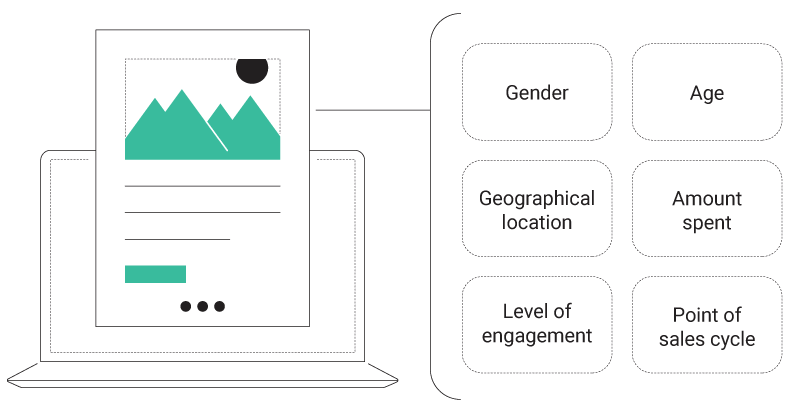Good marketing for your business is important. There is no better way to do so than by using your email lists. After all, you’ve invested both time and money collecting the contact information of potential customers. But if it simply sits on your computer collecting dust, you’re doing yourself a disservice.
Marketing your business means maintaining your visibility. Most businesses these days turn to social media but consider that email is 40 times more effective than social media in terms of acquiring customers.
Emails lists are an efficient and cost-effective way to market your product or service—if they’re used to their maximum potential. Already have an email list? It’s important to implement list segmentation. That’s a fancy way to say you need to divide up your email lists based on group characteristics.
For instance, you can divide up your lists based on who has purchased from you in the past versus who has not bought from you. You could also divide up your lists by shared characteristics or demographic information.
If you don’t already collect emails from customers and potential customers, you should start. In the meantime, consider purchasing email lists including business lists and consumer lists from a trusted data company rather than by price alone. Here’s why cheap email lists are never the right answer.
Ultimately, in segmenting your final list, versus having one or two huge email lists, you’re able to better speak to the needs of your audience. This also means the potential for higher open rates and more clicks—both of which are great for your business.
Earn ongoing business with segmented email lists
Your customers have no interest in being a number on your email list or on a cash register. One way to personalize their experience and earn their ongoing business is to show them they matter to you. Receiving an email that is tailored to their tastes, budget, or experiences is a simple way to stand out in someone’s inbox. The initial sorting of your existing list might take you some time but setting up this infrastructure within your email platform can help you reach more long-term marketing goals. Here are some ideas to get you started with segmenting your lists.

Gender: Men shop differently than women. This might not be as obvious if you’re selling pizza or coffee. However, if you’re prone to advertise things like clothing, shoes, or even housewares, this is one option that can make a huge difference to your email lists.
Age: There are things your customers need at any age and there are things they only want at a specific time in their life. Additionally, it’s important to use words, offers, and ads that truly speak to the age group of your audience if you want to capture their interest.
Geographical location: You can have a local restaurant or maybe you make cold weather gear. Either way, your audience is going to be highly targeted. Sorting out your email lists by where your customers and potential customers are located will help you reach them when the time is right.
Amount spent: Dividing up your email lists by how much someone has spent on your products or services is an excellent way to tailor your messaging. That’s not to say someone who made a small purchase will never splurge on something larger and vice versa, but being aware of which customers purchase what and for how much is one way to show you get them.
Level of engagement: Who are the customers that are always opening your emails? Which customers always seem to ignore everything you put in their inbox? Sorting your email lists by how active your users are is a great way to tailor your messaging and increase open rates.
Point of sales cycle: You’d speak differently to someone visiting your shop for the first time versus a customer who buys from you monthly. How long someone has been on your email list is an excellent way to gauge their familiarity with your business and tailor your email messaging to fit their needs.
Get started with email segmenting
Segmenting email lists can feel daunting. If you’re not sure where to begin, it’s okay—you’re not alone. More importantly, you’re probably already collecting information you need to segment yours lists even if you’re feeling directionless right now. Here’s how to get started.

Decide on your data points: Make a list of what data will help you sell to your email lists the most efficiently. You can base this list on your ICA (Ideal Customer Avatar) or Persona which every business, no matter their size, should have. From there, indicate what data you’re already collecting versus what data you want to collect moving forward.

Create your segments: You’re not tied to these segments forever, but you have to begin somewhere. Use your data points and get creative with your customer buckets based on information you already have on hand. For instance, even if you’re only collecting email addresses at this time you can sort your lists by opens.

Create tailored content: It will take time to find the right voice for your email lists. From the subject line you use to the offer you include to the story you tell to how often you make contact, everything is an experiment. Don’t be afraid to try a new tactic or re-work your segments based on reaction. The key is ongoing contact with your audience.

Update your collection tool: From asking about age group to geographical location to professional title, you’ll want to gain as many insights as you can from your customers and potential customers. Whether you’re looking to email a survey with basic questions that will help you deepen your segmentation or you want to collect more information from your sign ups on the front end, apply some of your missing data points to collect more information from customers.

Review, adjust, and repeat: From open rates to click rates to actual purchases, it’s important to measure the behavior of your email lists. Knowing what works—and what doesn’t—is one key to more sales. Because marketing varies, be prepared to play with a number of things: visuals, subject lines, time your message is sent—everything will vary from segment to segment.
Treat each customer like the unique individual they are through email to help boost your marketing results. By using email segments to ensure your messaging is more tailored as opposed to blanketed and generic you can personalize the connection you make with potential and existing customers. Ultimately this will help you maximize the impact every email send makes ensuring you’re on your way to more sales.






